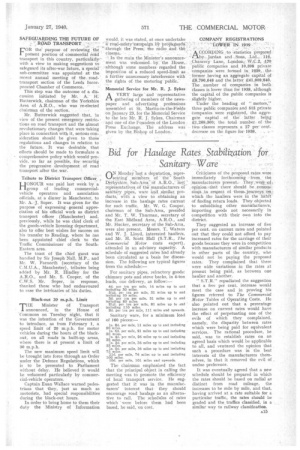Bid for Haulage Rates Stabilization for Sanitary Ware
Page 17

If you've noticed an error in this article please click here to report it so we can fix it.
ON Monday .last deputation, representing members of 'the' South Deabiehira. Sub Area Of A.R.O.a 'anat. representatives of -th'e manufacturers of sanitary pipes, ware and. earnilar. products, With a view to obtaining an increase in the haulage rates current for such traffic, Mr. W. G. Cooper, chairman of. the Sub-Area, presided and Mr. T. W. Thurman, secretary of the East Midland Area, A.R.O., and Mr. Hucker, secretary of the Sub-Area, were also present. • Messrs. T. Watson and W. J. Lloyd, interested hauliers, and Mr. H. Scott Hall (S.T,R., The Commercial Motor costs expert), attended in an advisory capacity. A schedule of suggested rates had already been circulated as a basis for discussion. The following are typical figures from the schedule:—
For sanitary pipes, refractory goods: chimney pots and stove backs, in 4-ton loads, one delivery, as follow:
4d, per ton per mile, 16 miles op to and including 30 miles. per ton per mile, 31 Yreka up to and including 50 miles.
3d. per ton per mile, 51 miles up to and including 80 miles. 2141. per ton per mile, 81 miles up to and including 110 miles.
24. per. ton per mile, 111 miles and upwards.
Sanitary ware, for a minimum load of 160 pieces:— is, ad. per mile, n miles up to and including 20 miles.
is. 6d. per mile, 21 miles up to and including 25 miles.
Is. 4c1. per mile, 26 miles up to and including 35 miles.
ls. 2d. per mile, 36 miles up to and including 55 miles.
Is. Od. per mile, 56 miles up to and including 75 miles.
Ild, per mile, 76 .miles up to and including 100 miles.
lOrt, per mile, 101 miles and upwards.
The chairman emphasized the fact that the principal object in calling the meeting was to promote the efficiency of local transport service. He suggested that it was in the manufacturers' interest that they should encourage road haulage as an alternative to rail. The schedules of rates which 'were before them had been based, he said, on cost. •
Criticisms of the propased.rates were immediately forthcoming -from' the manufacturers presentThey ,vaor.a. pf. opinion -that there should be toncessionsin -respet of thoseajciunieys on which the hauliers were in the habit of finding return loads. They objected to subsidising other manufacturers, importing goods not necessarily in competition with their own into the district.
They suggested an increase of five per cent, on current rates and pointed out that they could not afford to pay increased rates for the carriage of their goods because they were in competition with manufacturers of similar products in other parts of the country, who would not be paying the proposed rates. They complained that there were wide variations in the rates at present being paid, as between one haulier and another,
" S.T.R." repudiated the suggestion that a five per cent. increase would meet the case and in proving his figures referred to The Commercial Motor Tables of Operating Costs. He also pointed out that a percentage increase on current rates would have the effect of perpetuating one of the evils of which they complained, namely, the disparity between rates which were being paid for equivalent services. The rational procedure, he said, was to establish rates on an agreed basis which would be applicable to all, and ventured the opinion that such a procedure was in the best interests of the manufacturers themselves, in that it removed the evil of , undue preference.
It was eventually agreed that a new schedule should be prepared in which the rates should be based on radial as distinct from road mileage, the increases to be mile by mile, and that, having arrived at a rate suitable for a particular traffic, the rates should be graded and the traffics classified, in a similar way to railway classification.




















































